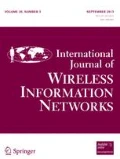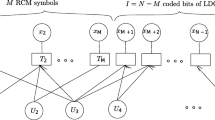Abstract
A close-form expression for the exact Pair-wise Error Probability (PEP) of Space-Time (S-T) codes in Rayleigh fading channel is derived using the general and close-form solution for the probability-density function (PDF) of a sum of independent exponential distributed random variables. The expression requires evaluating the coefficients for partial fraction expansion, so an easy analytical way is proposed for doing this. The exact PEP is subsequently used to develop a simple PEP using the upper bound. Both PEPs are used in the Union bound for error rate evaluation. Numerical calculations and Monte Carlo computer simulation are used to study the accuracies of these Union bounds for error rate evaluation of a rotation-based diagonal S-T code (D code) in Rayleigh fading channels. Four other PEPs based on different bounds, i.e., the Chernoff bound, the asymptotic bound, the tight asymptotic bound, and the Eigen-Geometric-Mean (EGM) bound, are also studied for comparison. Results show that our derived close-form PEP is an exact PEP and our proposed PEP is a very tight bound to the exact PEP.


Similar content being viewed by others
References
V. Tarokh, N. Seshadri and A. R. Calderbank, Space–time codes for high data rate wireless communication: Performance criterion and code construction, IEEE Transactions on Information Theory, Vol. 44, No. 3, pp. 744–765, 1998.
S. Benedetto and E. Biglieri, Principles of Digital Transmission with wireless applications, Kluwer, New York, 1999.
G. Taricco and E. Biglieri, Exact pairwise error probability of space-time codes, IEEE Transactions on Information Theory, Vol. 48, No. 2, pp. 510–513, 2002.
M. Uysal and C. N. Georghiades, On the error performance analysis of space-time trellis codes, IEEE Transactions on Wireless Communications, Vol. 3, No. 4, pp. 1118–1123, 2004.
H. F. Lu, Y. K. Wang, P. V. Kumar and K. M. Chugg, Remarks on space-time codes including a new lower bound and an improved code, IEEE Transactions on Information Theory, Vol. 49, No. 10, pp. 2752–2757, 2003.
M. K. Simon and M. S. Alouini, Digital Communication Over Fading Channels, vol. 2nd, Wiley, New York, 2005.
M. P. Fitz, J. Grimm, and S. Siwamogsatham, A new view of performance analysis techniques in correlated Rayleigh fading, 1999 IEEE Wireless Communications and Networking Conference, Vol. 1, pp. 139–144, 1999.
M.-K. Byun and B. G. Lee, New bounds of pairwise error probability for space-time codes in Rayleigh fading channels, IEEE Transactions on Communications, Vol. 55, pp. 1484–1493, 2007. doi:10.1109/TCOMM.2007.902532.
B. Vucetic and J. H. Yuan, Space-time coding, Wiley, UK, 2003.
J. G. Proakis, Digital Communications, vol. 4th, McGraw-Hill, Boston, USA, 2001.
H. V. Khuong and H. Y. Kong, General expression for pdf of a sum of independent exponential random variables, IEEE Communications Letters, Vol. 10, pp. 159–161, 2006. doi:10.1109/LCOMM.2006.1603370.
A. V. Oppenheim and A. S. Willsky, Signals and Systems, Prentice-Hall, Englewood Cliffs, 1983.
T. Eng and L. B. Milstein, Coherent DS-CDMA Performance in Nakagami Multipath fading, IEEE Transactions on Communications, Vol. 43, No. 2, pp. 1134–1143, 1995.
J. W. Craig, A new, simple and exact result for calculating the probability of error for two-dimensional signal constellations, in IEEE MILCOM 1991, Vol. 2, pp. 571–575, 1991.
S. G. Wilson, Digital Modulation and Coding, Prentice Hall, NJ, 1996.
R. K. Mallik and Q. T. Zhang, A tight upper bound on the PEP of a Space-Time Coded system, IEEE Transactions on Wireless Communications, Vol. 6, pp. 3238–3247, 2007.
H. Yao and G. Wornell, Achieving the full MIMO diversity-multiplexing frontier with rotation-based space-time codes, Annual Allerton Conference on Communication, Control and Computing, Monticello, IL, 2003.
P. W. Wolniansky, G. J. Foschini, G. D. Golden, and R. A. Valenzuela, V-BLAST: an architecture for realizing very high data rates over the rich-scattering wireless channel, 1998 URSI International Symposium on Signals Systems and Electronics, ISSSE 98, pp. 295–300, 1998.
Z. Zhang, S. W. Cheung, T. I. Yuk, and H. Kuo, Union bounds for BER evaluation and code optimization for space-time codes in 2-by-2 MIMO systems, 2006 IEEE Spring Vehicular Technology Conference, Vol. 3, pp. 1506–1510, 2006.
Z. Zhang, X. G. Dai, S. W. Cheung, and T. I. Yuk, A common function of different union bounds for optimization and BER evaluation of space-time codes, Wireless Personal Communications, Vol. 46, pp. 493–506, 2008.
Author information
Authors and Affiliations
Corresponding author
Appendices
Appendix 1
For two distinct eigenvalues, A r,s can be easily determined. For R distinct eigenvalues, partial-fraction expansion can be used as:
In (27), partial-fraction expansion is used in Step 1 to split the product term \( \left( {1 - j\omega \tilde{\lambda }_{1} } \right)^{{ - MW_{1} }} \left( {1 - j\omega \tilde{\lambda }_{2} } \right)^{{ - MW_{2} }} \) into MW 1 + MW 2 terms. In Step 2, each of these MW 1 + MW 2 terms is multiplied by \( \left( {1 - j\omega \tilde{\lambda }_{3} } \right)^{{ - MW_{3} }} \)and partial-fraction expansion is then used again to split each of these MW 1 + MW 2 product terms. The same procedures continue until the last distinct eigenvalue item \( \left( {1 - j\omega \tilde{\lambda }_{R} } \right)^{{ - MW_{R} }} \) is done and so A r,s is determined.
Although r could take on a value of 1, …, R, without loss of generality, we can initially consider the case with r = 1, i.e., A 1,s . We denote \( A_{{1,k_{i} }}^{i} \) as the coefficient for the item \( \left( {1 - j\omega \tilde{\lambda }_{1} } \right)^{{ - k_{i} }} \) in Step 1 of (27). Then in every step of (27), it is sufficient to only consider the items \( \left( {1 - j\omega \tilde{\lambda }_{1} } \right)^{{ - k_{i} }} \) with k i ≥ s because only such items can produce \( \left( {1 - j\omega \tilde{\lambda }_{1} } \right)^{ - s} \) in the process of partial fraction expansion. In Step 1, the result is:
In Step 2, the terms \( \frac{{A_{{1,k_{1} }}^{1} }}{{\left( {1 - j\omega \tilde{\lambda }_{1} } \right)^{{k_{1} }} }} \) in the result of Step 1 with k 1 ≥ s are multiplied by \( \frac{1}{{\left( {1 - j\omega \tilde{\lambda }_{3} } \right)^{{MW_{3} }} }} \) and then partial-fraction expanded. So \( A_{{1,k_{2} }}^{2} \), the coefficient for \( \left( {1 - j\omega \tilde{\lambda }_{1} } \right)^{{ - k_{2} }} \) with k 2 ≥ s in Step 2, is:
The process repeats until the last step, Step R-1, so:
Repeat the process of substituting \( A_{{1,k_{i} }}^{i} \) into \( A_{{1,k_{i + 1} }}^{i + 1} \) for i = 1 to R-2, we obtain A 1,s . After introducing R-1 variables: \( t_{i} = k_{i - 2} - k_{i - 1} \), for i = 3, …, R, and \( t_{2} = MW_{1} - k_{1} \), the result of the above process can be written in a compact way:
Applying the same procedures for r = 2, …, R and adding the constraint i ≠ r produce (8).
Appendix 2
First, we define the following integrals:
Then we prove the following differential relationship between P(N) and P(N-1):
It can be easily shown that:
.
Using mathematical induction, (35) can be obtained:
(35) is the exact PEP for equal-eigenvalue case, which was proved in [13] by simplifying the Gaussian hyper-geometric function. However, the proof here is much simpler.
To prove the equivalence of (13) and (14), it only needs to prove:
We regard the right hand side of (36) as a function of N and rearrange it as:
where:
Substitute (38) into (37), we have:
which indicates that \( \tilde{P}(N) \) has the identical differential relationship to P(N) and it is easy to verify they are equal for N = 1. So we can conclude that:\( \tilde{P}(N) = P(N) \)or (13) and (14) are equivalent to each other.
Appendix 3
Substituting (15) and (7) into (12) yields a new PEP for the equal-eigenvalue case:
Note that: \( \left( {\frac{1}{4}} \right)^{N} \left( {\begin{array}{*{20}c} {2N} \\ N \\ \end{array} } \right) \) is less than 1 and decreases with the increase of N. So if SNR is not too low (say, \( \lambda SNR > \frac{4}{3} \)), (40) is tighter than the Chernoff bound of (20).
Substituting the differential relationship of (33) into (40) gives:
Rearranging (41) yields:
Taking N-1 as the new argument gives:
which is the proof of (17).
Rights and permissions
About this article
Cite this article
Zhang, Z., Cheung, S.W. & Yuk, T.I. An Exact Close-form PEP and a new PEP for Space-Time Codes in Rayleigh Fading Channels. Int J Wireless Inf Networks 16, 22–32 (2009). https://doi.org/10.1007/s10776-009-0095-z
Received:
Accepted:
Published:
Issue Date:
DOI: https://doi.org/10.1007/s10776-009-0095-z




